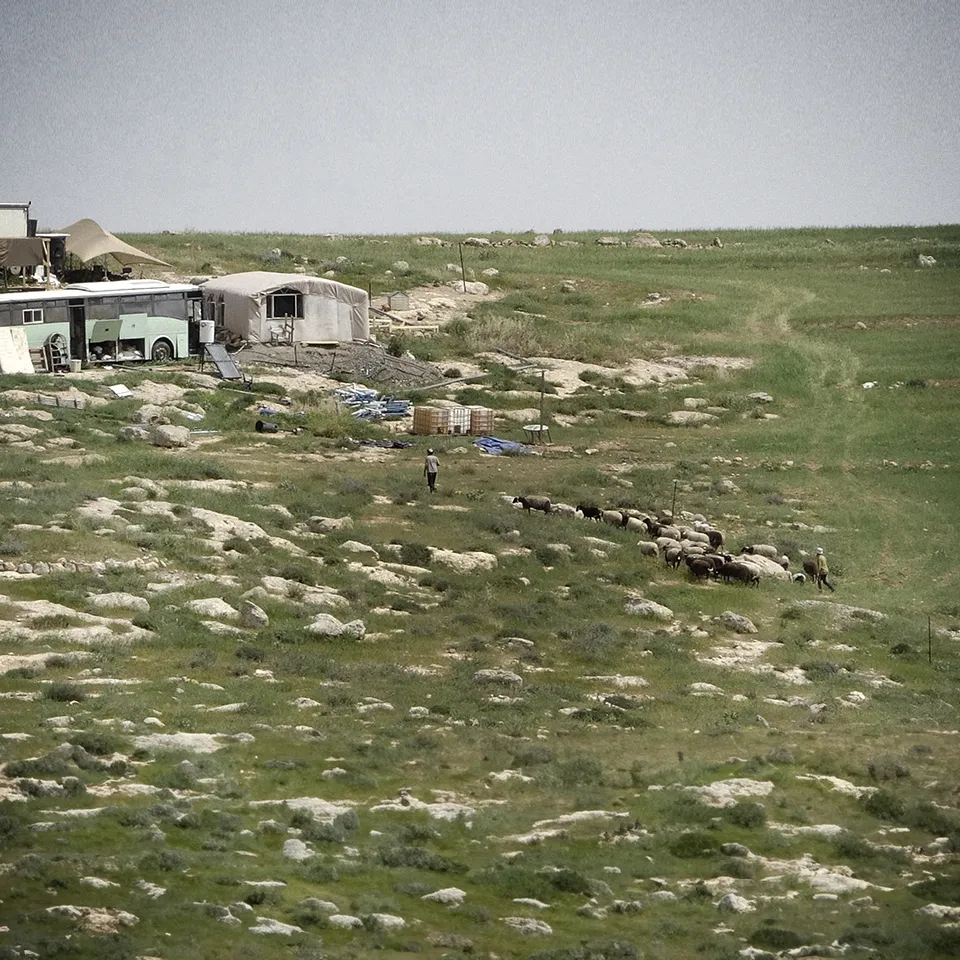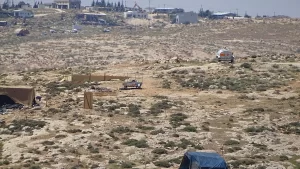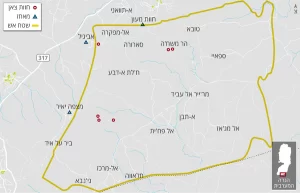The occupation entrenches itself deep in Palestinian lands

JVL Introduction
We have posted before about Palestinian struggles to hold onto their lands in the South Hebron Hills.
In a story inititated by the Villages Group, Amira Hass reports on the latest developments – Israelis farming on lands declared army firing zones in order to expel the Palestinian inhabitants.
Thus, inch by inch, dunam by dunam, the occupation is allowed to entrench itself…
RK
This article was originally published by Haaretz on Fri 2 Jun 2023. Read the original here.
Israeli Settlers Allowed to Live in West Bank Firing Zone After Palestinians Were Evacuated
Six sheep farms operate in Masafer Yatta, south of Mount Hebron, and the young men who stay there violently drive the Palestinian residents of the area away from their grazing lands
The state is allowing six sheep farms run by Israelis to operate in Masafer Yatta, a region in the southern West Bank that’s been declared a firing zone, after the justices of the High Court of Justice allowed the expulsion of its Palestinian residents. Each one of these farms has at least one flock.
The farms were erected close to the illegal outposts of Mitzpeh Yair, Avigayil and Havat Ma’on. Palestinians monitoring events in the area report that two of these farms were established before the High Court ruling of May 2022, and that at least three were built subsequently. The Coordinator of Government Activities in the Territories says it isn’t familiar with these farms and that if they are identified, legal action will be taken against them. However, Haaretz has learned that the Civil Administration, which is subordinate to COGAT, has issued administrative injunctions – stop-work and demolition orders – on these farms. Authorities demolished one of the farms in the past, but it was rebuilt.

A sheep farm east of Ma’on Farm outpost, this year. Credit: Guy Botavia, Ta’ayush
An Israeli living nearby told Haaretz that settlers and Israel Defense Forces officers told him that Jewish flock owners in the area were given grazing permits in Masafer Yatta, but that they didn’t show him any documents to confirm their claims. COGAT did not respond to a Haaretz query regarding the allocation of grazing areas in an army firing zone.
Despite the injunctions, local Palestinian residents and Israeli human rights activists have noted continuous and brisk activity around these farms, with trucks unloading, a cement truck laying down a concrete surface and all-terrain vehicles entering and leaving the farms, as well as people on horseback. The old sheep pens and tents, as well as new ones that have been added on recently, are visible from a distance. One of the farms also raises camels. Palestinians in the area say that they often see soldiers in the vicinity of Israeli shepherds, accompanying them within the firing zone.

Three farms were built east of Mitzpeh Yair, in an area the Palestinians call Wadi al-Gat. The first one was built two years ago. The second, a little south of the first, was built a year ago, taking over dwelling caves that have been used by Palestinians for decades. The third farm was built a few weeks ago, deeper inside the declared firing zone, in an area where one can clearly see stone fences and caves set up for dwelling years ago by local Palestinians.
The fourth farm was built east of the Avigayil outpost shortly before the High Court ruling. It has at least one flock. Two other farms were built on the Mashakha hill, east of Havat Ma’on, on the former site of this very outpost, which was removed by the army in 2004. Local residents and activists note that these farms are occupied mainly by religious youth who take the flocks to graze during the day and stay there overnight. Older settlers, known within the settler community and to the army, live in the older outposts and are apparently
This mode of operation is familiar from other sheep and cattle farms that have been established in the West Bank: one responsible adult or family receives a flock of sheep, while a group of religious youths live and work on the farm, taking the sheep out to graze. This phenomenon has expanded and been consolidated particularly over the last decade. There are currently 23 such farms (including these six) just in the South Hebron Hills.
Just as in other parts of the West Bank, testimonies from Masafer Yatta indicate that the Israeli shepherds use intimidation and violence to push Palestinian shepherds and residents off grazing grounds they’ve been using for decades, as well as blocking their access to the water cisterns they or their parents dug out a long time ago. According to testimonies, Israeli shepherds in Masafer Yatta release their flocks on Palestinian barley fields or through their groves, as in other parts of the West Bank, with the flocks decimating harvests. The army had previously closed off some of these plots, declaring them military zones closed to Israelis after settlers entered them and clashes erupted.
Attorney Roni Pelli from the Association of Civil Rights in Israel, the organization that together with attorney Shlomo Lecker has represented Palestinian residents in Masafer Yatta since 1999, told Haaretz that “historical documents show that even 40 years ago, declaring an area a firing zone was done to expel its residents. Following such a ruling, the army makes things more difficult, making residents’ lives unbearable. Recently, some outposts have sprung up in the area, with growing settler violence.
A sheep farm established east of the Mitzpe Yair outpost in the West Bank, this year. The Palestinians call the area Wadi al Gat (Valley of the Cat).Credit: Guy Botavia, Ta’ayush
“Like in other places across the West Bank, the residents of Masafer Yatta have been left to their fates, with the army doing nothing to protect their lives and property. The difference between them and other places is that no one is hiding the intention of expelling them from the area, with all means for doing so considered legitimate. One should note that the expulsion of protected residents is prohibited and could constitute a war crime, even when it’s done by making their lives impossible.”

A sheep farm established east of the Mitzpe Yair outpost in the West Bank, this year. The Palestinians call the area Wadi al Gat (Valley of the Cat). Credit: Guy Botavia, Ta’ayush
In Masafer Yatta, which lies southeast of the city of Yatta, there have been cave-hamlets since the 19th century, occupied by shepherds who lived in them most of the year, growing wheat, barley and vegetables for their own use. Toward the end of the spring and in the summer, some of them moved westward, to the villages of Yatta, Dura and Samoa. The cave-hamlets, like other small Palestinian villages across the country, were first formed as natural and recognized extensions of existing villages where the population had increased, or when there was a need to expand grazing grounds, or to look for new water sources. Over time, they became regular, permanent villages.
In the village of Jinba, stone dwellings were built early in the 20th century. The IDF blew up most of them in 1966. In the early ’80s, the IDF declared an area spanning 30,000 dunams (7,413 acres) as firing zone 918, following a recommendation that Defense Minister Ariel Sharon made to the defense establishment, as a way of blocking the expansion and consolidation of existing Palestinian villages in the area. Despite this declaration, the residents of 12 small villages continued to live in the area, in their caves and the tents that they erected over time outside of them. Military exercises, if any, took place in limited areas. Nevertheless, Israeli authorities forbade the erection of permanent dwellings or any connection to water and electricity infrastructure.
In 1999, in the midst of the Oslo process and with Ehud Barak as prime minister and defense minister, the IDF expelled 700 residents of the small villages in the area, demolishing their structures and cisterns. Following a petition, the High Court issued a temporary injunction, allowing them to return but not to rebuild their structures or cisterns or to build new ones. They were also forbidden to build any connecting roads. Many structures that for lack of choice were subsequently reconstructed or built without permits have been declared illegal by the Civil Administration.
After much foot-dragging by the state and despite several attempts at bridging between the residents and Israeli authorities, the state insisted on viewing these residents as invaders of the firing zone. The residents continued with their court appeals against the demolition of their homes and their expulsion. In May 2022, the justices rejected the appeal against the existence of the firing zone and obliged the plaintiffs, some of the poorest people among the Palestinians, to pay 40,000 shekels ($10,700) in court expenses. Since this ruling, Israel has not evicted these residents in practice, but has taken steps to make their lives even harder. It has sped up the demolition of dwellings and a school, confiscated vehicles, added military roadblocks and keeps detaining Palestinian shepherds every now and then.

And of course it’s the Israeli Supreme Court as presently constituted which has ordered the expulsion of Palestinians from this part of Greater Israel, stretching from the river to the sea.